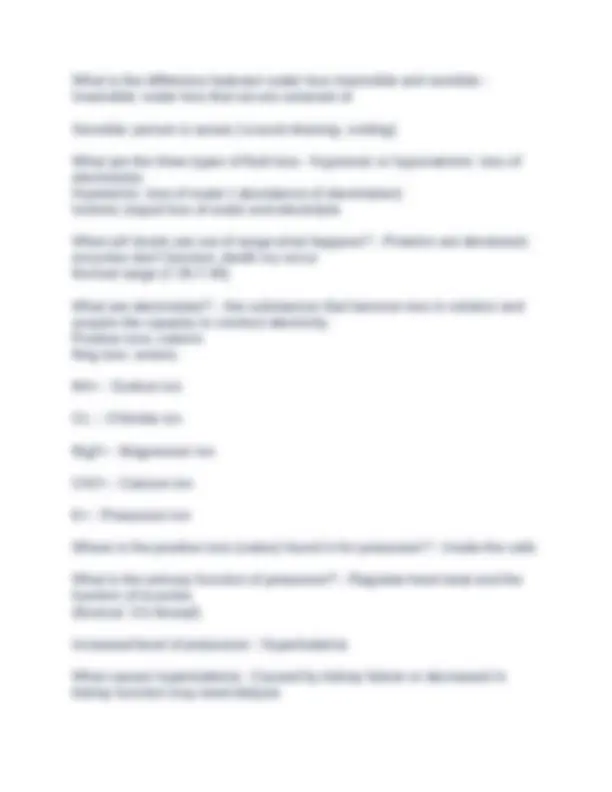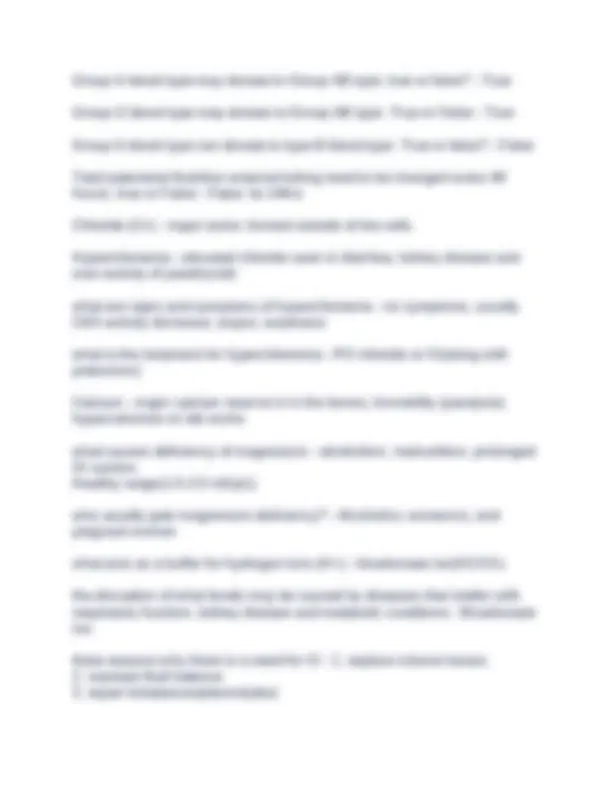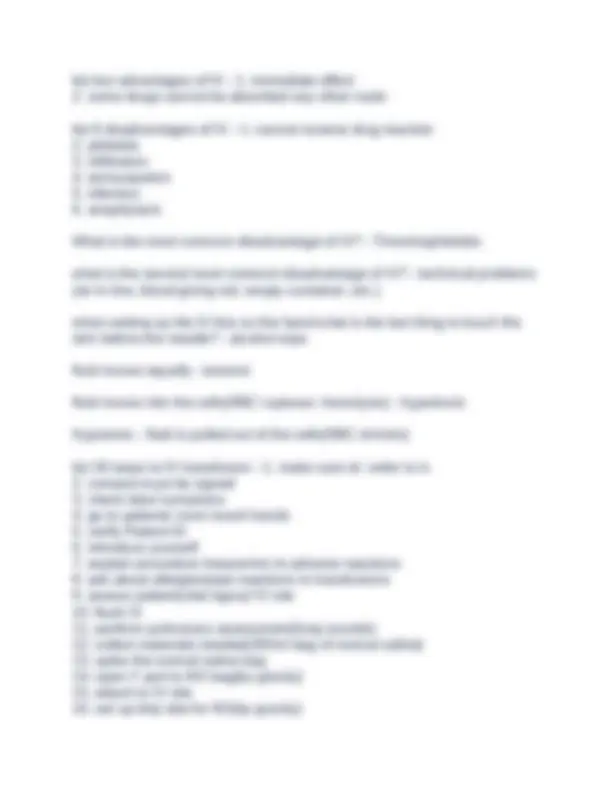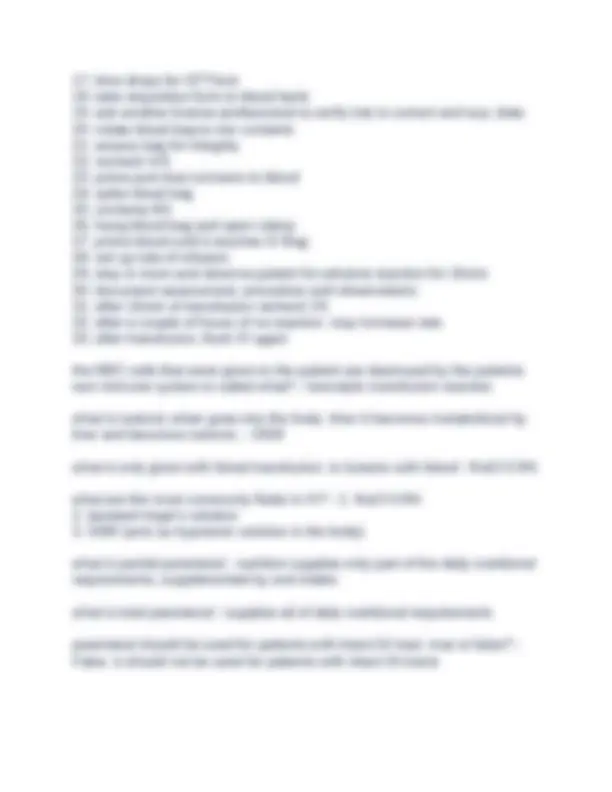








Study with the several resources on Docsity

Earn points by helping other students or get them with a premium plan


Prepare for your exams
Study with the several resources on Docsity

Earn points to download
Earn points by helping other students or get them with a premium plan
Community
Ask the community for help and clear up your study doubts
Discover the best universities in your country according to Docsity users
Free resources
Download our free guides on studying techniques, anxiety management strategies, and thesis advice from Docsity tutors
Iv certification class review for test
Typology: Exams
1 / 10

This page cannot be seen from the preview
Don't miss anything!







Steps after transfusion reaction step 1 - Turn off blood Steps after transfusion reaction step 2 - Hang normal saline Steps after transfusion reaction step 3 - Take vitals Steps after transfusion reaction step 4 - Call attending Steps after transfusion reaction step 5 - Position patient Steps after transfusion reaction step 6 - Call blood bank Steps after transfusion reaction step 7 - Send blood and tubing to lab Steps after transfusion reaction step 8 - Urine test Steps after transfusion reaction step 9 - Input and Output Steps after transfusion reaction step 10 - Meds as ordered Steps after transfusion reaction step 11 - Documentation ABO blood groups - Every unit crossmatched is remove from the general inventory and reserve for the patient for 72 hrs. A full crossmatched procedure takes hoe long to complete and cannot be shortened - 45 min
What are frigerated until use? - Units A how much blood must be properly labeled and must be checked before use - 1 unit of blood Blood compatibility Anitbodies: B Antigens: A - Group A Blood compatibility Anitbodies: A Antigens: B - GROUP B Blood compatibility Anitbodies: none Antigens: AB - Group AB Blood compatibility Anitbodies: AB Antigens: none - Group O Antigen - A substance that can initiate an immune response and induce the formation of corresponding antibody. The established major antigens found in blood are inherited such as those in the ABO system in exogenous sources IE blood transfusions Antibody - Immunoglobulin molecule produced in response to a specific antigen Euythocytes - RBC Leukocytes - WBC Platelets - Cell fragments for clotting Blood physiology - Supplies O2, transports cellular waste, defense against infections, regulates body temperature, acid base balence
What can the lvn do when directed by a physical and surgeon? - Administer medication by hypodermic injection, approved by board school and in structed by the doctor after demonstrating competency withdraw blood from a patient,( board pass or competency.) Lvn may start or superimpose iv fluid only if all of the following occured: - 1. completed a course approved by the board/state,
What is the difference between water loss insensible and sensible - Insensible: water loss that we are unaware of Sensible: person is aware ( wound draining, voiding) What are the three types of fluid loss - Hypotonic or hyponatrimic: loss of electrolytes Hypertonic: loss of water ( abundance of electrolytes) Isotonic (equal loss of water and electrolyte When pH levels are out of range what happens? - Proteins are denatured, enzymes don't function, death my occur Normal range (7.35-7.45) What are electrolytes? - Are substances that become ions in solution and acquire the capacity to conduct electricity. Positive ions: cations Neg ions: anions. NA+ - Sodium ion CL- - Chloride ion Mg2+ - Magnesium ion CA2+ - Calcium ion K+ - Potassium Ion Where is the positive ions (cation) found in for potassium? - Inside the cells What is the primary function of potassium? - Regulate heart beat and the function of muscles (Normal: 3.5-5meq/l) Increased level of potassium - Hyperkalemia What causes hyperkalemia - Caused by kidney failure or decreased in kidney function may need dialysis
Periatic and geriatric population often use fluid control delivery systems such as buretrol. True or false - True During blood withdrawal, it is permitted to move the Vacutainer and needle while changing blood collection tubes to her false? - False when performing venipuncture the bevel should be pointed down. true or false? - False piggyback or secondary bags should be hung lower than the primary bags. true or false - False IV pumps are generally silent when they detect air bubbles in the tubing. true or false? - False drip factor (gtt/min) of IV tubing is found on the manufacturers' package. true or false? - True one of the reason for central line placement is surgery for simple appendectomy. true or false? - False currently what is the percentage Is estimated to have IV therapy during their hospital stay? - 80% it is becoming more common to find patients with central in out of the hospital setting. true or false - true the RN Can't merely "sign off" on data collected by the LVN. true or False - True the LVN may withdraw blood from a patient if previously been instructed by a physican or surgeon. True or false? - true LVNs who are IV Certified may start peripheral IV's, superimpose IV solutions, withdraw blood and perform arterial blood gas withdrawal. true or false? - False an RN may delegate or assign simple heparin flushes to clear out cental line to an LVN team member. True or False? - False
Group A blood type may donate to Group AB type. true or false? - True Group O blood type may donate to Group AB type. True or False - True Group A blood type can donate to type B blood type. True or false? - False Total patenteral Nutrition external tubing need to be changed every 48 Hours. true or False - False: its 24hrs Chloride (Cl-) - major anion, formed outside of the cells. Hyperchloremia - elevated chloride seen in diarrhea, kidney disease and over activity of parathyroid. what are signs and symptoms of hyperchloremia - no symptoms, usually CNS activity decrease, stupor, weakness what is the treatment for hyperchloremia - PO chloride or IV(along with potassium) Calcium - major calcium reserve is in the bones, Immobility (paralysis) hypercalcemia on lab works what causes deficiency of magnesium - alcoholism, malnutrition, prolonged GI suction, Healthy range(1.5-2.5 mEq/L) who usually gets magnesium deficiency? - Alcoholics, anorexics, and pregnant women what acts as a buffer for hydrogen ions (H+) - bicarbonate ion(HCO3-) the disruption of what levels may be caused by diseases that intefer with respiratory function, kidney disease and metabolic conditions - Bicarbonate Ion three reasons why there is a need for IV - 1. replave volume losses.